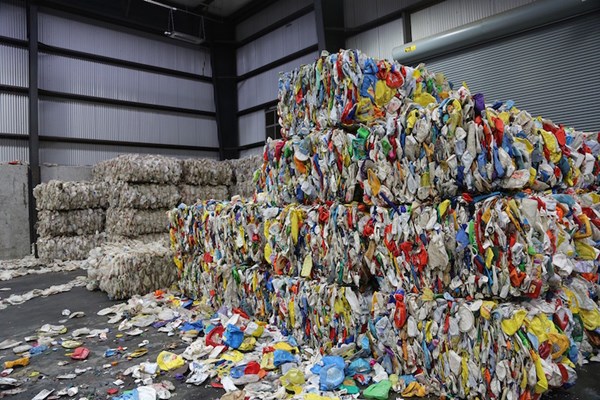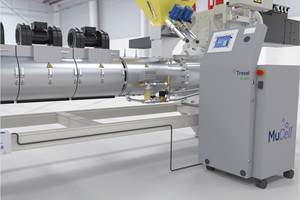New Plastics Recovery Facility To Open in Baltimore
One of the biggest barriers to increasing recycling rates is a lack of infrastructure.

One of the biggest barriers to increasing recycling rates is a lack of infrastructure. In 2013, lack of recycling infrastructure caused U.S. cities to collectively spend over $5 billion dollars to landfill over $11 billion worth of commodities that could have been recycled, according to Closed Loop Fund, which is a consortium aimed at providing municipalities access to zero- and low-interest loans to build comprehensive recycling programs. Partners include big corporations such as 3M, Coca-Cola, Colgate-Palmolive, Goldman Sachs, Johnson & Johnson Family of Consumer Companies, Keurig Green Mountain, PepsiCo and the PepsiCo Foundation, Procter & Gamble, Unilever, Walmart and the Walmart Foundation.
The fund plans to invest $100 million in the U.S. recycling infrastructure by 2020.
Closed Loop Fund’s first investee is a joint venture between QRS and Canusa- Hershman (CHR) to create what it calls a “one-of-a-kind” Plastic Recovery Facility (PRF) in Baltimore.
Currently, 40% of communities across the U.S. are not able to collect and recycle #3 - #7 plastics. QRS and CHS will combine technology that can both separate these products and turn them back into raw materials for new products and packaging. The facility is able to process 4,500 tons of materials every month – double the capacity of what’s presently possible in the U.S. The group believes that this will help drive significant increase in recovery of hard-to-recycle plastics and ensure a stable market.
Beginning in November, QRS-CHR will service the majority of the East Coast – from Maine to South Carolina. The opening of the facility is expected to help divert 440,000 tons from landfills and reduce 555,000 tons of greenhouse gas emissions. Closed Loop Fund says that QRS-CHR is a 大象传媒 model that can be replicated across the U.S. and beyond.
"QRS-Canusa's newest Plastic Recovery Facility in Baltimore provides all communities and recyclers throughout the Northeast and Mid-Atlantic regions with a reliable, domestic processing solution for mixed, post-consumer plastic containers,” said Greg Janson, CEO of QRS. “Working in conjunction with other QRS facilities, the Baltimore PRF targets virtually all polymers in the single stream mix for recovery, returning high volumes of quality material to the manufacturing base. This purpose nests perfectly with the mission of the Closed Loop Fund and we are excited for their support of the project."
Additional investments
Closed Loop Fund’s two other investments are in Quad Cities, Iowa, and Portage County, Ohio. These investments will allow the two communities to convert from dual stream recycling systems to single stream, making it easier for citizens to recycle and significantly increasing recycling rates. Again, Closed Loop says that the funding will prove models that help expand single stream recycling to similar communities across the country.
Over the next 10 years, in Portage County alone, 37,000 tons will be diverted from landfills with a reduction of 110,000 tons of greenhouse gas emissions. Quad Cities is expected to see 86,000 tons diverted from landfills and 250,000 tons of greenhouse gas emissions reduced.
“We’ve spent months reviewing proposals from cities and recycling facilities that have the potential to transform recycling systems across the country,” said Rob Kaplan, co-founder and managing director of Closed Loop Fund. “We know that when done right, recycling is a profitable 大象传媒 that can save city and taxpayer money. That’s why Closed Loop Fund invests in 大象传媒 models like QRS-Canusa, Quad Cities and Portage County that solve key bottlenecks in the recycling system, create economic value for cities, and make recycling more accessible for citizens.”
Closed Loop Fund has pretty big goals. By 2025, it aims to do the following:
- Reduce greenhouse gas emissions by more than 50 million GHG tons reduction
- Divert more than 20 million cumulative tons of waste from landfills
- Create 20,000+ local jobs across the U.S.
- Save nearly $1.2 billion for American cities
- Prove replicable models that will help unlock additional investment in recycling.
Related Content
Republic Services and Ravago in Partnership to Build Recycling Capacity
Planned facilities will have a combined output of 300 million pounds of recycled plastics.
Read MorePET Chemical Recycling Process Qualified and Commercialized
Process will be offered as a license package globally by Axens.
Read MoreFoam-Core Multilayer Blow Molding: How It’s Done
Learn here how to take advantage of new lightweighting and recycle utilization opportunities in consumer packaging, thanks to a collaboration of leaders in microcellular foaming and multilayer head design.
Read MoreNovel Line Turns Fluff to Blown Film
Processor Bioflex of Mexico is utilizing Reifenhäuser Blown Film’s EVO Fusion technology to integrate postindustrial and postconsumer recycled materials into products.
Read MoreRead Next
Making the Circular Economy a Reality
Driven by brand owner demands and new worldwide legislation, the entire supply chain is working toward the shift to circularity, with some evidence the circular economy has already begun.
Read MorePeople 4.0 – How to Get Buy-In from Your Staff for Industry 4.0 Systems
Implementing a production monitoring system as the foundation of a ‘smart factory’ is about integrating people with new technology as much as it is about integrating machines and computers. Here are tips from a company that has gone through the process.
Read More












